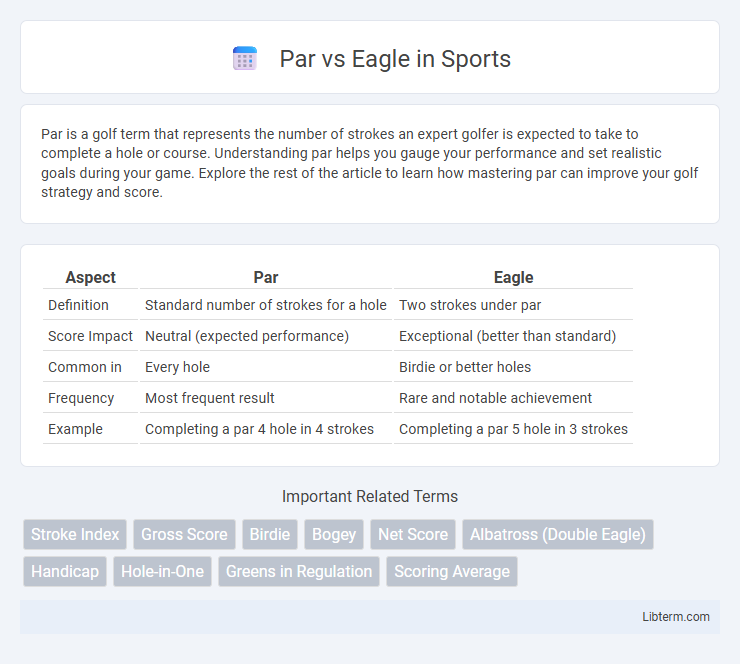Par is a golf term that represents the number of strokes an expert golfer is expected to take to complete a hole or course. Understanding par helps you gauge your performance and set realistic goals during your game. Explore the rest of the article to learn how mastering par can improve your golf strategy and score.
Table of Comparison
| Aspect | Par | Eagle |
|---|---|---|
| Definition | Standard number of strokes for a hole | Two strokes under par |
| Score Impact | Neutral (expected performance) | Exceptional (better than standard) |
| Common in | Every hole | Birdie or better holes |
| Frequency | Most frequent result | Rare and notable achievement |
| Example | Completing a par 4 hole in 4 strokes | Completing a par 5 hole in 3 strokes |
Understanding Par and Eagle in Golf
Par represents the standard number of strokes an expert golfer is expected to complete a hole, serving as a benchmark for performance. An eagle occurs when a player completes a hole two strokes under par, indicating exceptional skill and precision. Understanding the difference between par and eagle helps golfers gauge their proficiency and improves strategic decision-making on the course.
The Origins of Golf Scoring Terms
The origins of golf scoring terms like "par" and "eagle" trace back to early 20th-century American golf culture, where "par" symbolized an expert golfer's expected number of strokes on a hole, derived from the term's general meaning of "perfect score." The "eagle" originated as slang for achieving two strokes under par, extending the bird-themed scoring system that started with "birdie," meaning one stroke under par. These terms entrenched themselves internationally due to golf's rising popularity and the poetic analogy between bird types and scoring excellence.
Defining Par: The Benchmark Score
Par represents the standard number of strokes an expert golfer is expected to take to complete a hole or course, typically set by course designers based on distance and difficulty. It serves as a benchmark score for evaluating performance, with players aiming to meet or beat this standard. Understanding par is crucial for interpreting scores like eagle, which indicates completing a hole two strokes under par.
What Is an Eagle in Golf?
An eagle in golf is a score that is two strokes under par on a single hole, representing a significant achievement in the game. For example, scoring a 3 on a par-5 hole or a 2 on a par-4 hole qualifies as an eagle. This rare accomplishment showcases exceptional skill and precision, often leading to a strong advantage in competitive play.
Key Differences Between Par and Eagle
Par represents the expected number of strokes a skilled golfer should take to complete a hole, typically set by the course rating and hole length, while an Eagle signifies a score two strokes under par on a single hole. Scoring a par reflects meeting the standard performance, whereas an Eagle indicates exceptional skill and significantly better performance on that hole. These differences impact a player's overall score and are critical metrics for assessing golfing proficiency and competitiveness.
How to Achieve Par vs Eagle
Achieving par involves completing a hole in the expected number of strokes, which requires consistent accuracy and course management to avoid hazards and optimize approach shots. An eagle demands exceptional skill by finishing the hole two strokes under par, often requiring long, precise drives combined with precise approach shots or successful putts from a considerable distance. Mastery of club selection and shot execution plays a critical role in transitioning from par to eagle during a round of golf.
Strategic Play: Aiming for Eagle or Settling for Par
Strategic play in golf often revolves around the decision to aim for an eagle, which requires precise risk assessment and aggressive shot-making, or to settle for par, emphasizing consistency and course management. Players targeting an eagle must carefully evaluate hazards, pin placement, and their own skill level, balancing potential rewards against the possibility of score-damaging mistakes. Opting for par prioritizes minimizing errors, maintaining steady performance, and leveraging strategic positioning to stay competitive throughout the round.
The Rarity of Eagles in Golf
Eagles in golf represent a rare and impressive achievement, occurring far less frequently than pars, which are the standard scoring expectation for each hole. The difficulty of making an eagle stems from the need to complete a hole in two strokes under par, often requiring a combination of powerful drives and precise approach shots. Statistically, eagle occurrences are significantly lower, highlighting the skill and precision needed to achieve this rare score during competitive play.
Impact of Par and Eagle on Your Scorecard
Par serves as the baseline score expected on each hole, directly influencing the total score by setting the standard for performance. Achieving an eagle, which is two strokes under par, significantly lowers your scorecard, demonstrating exceptional skill and often improving your overall placement in the game. Understanding the impact of par and eagle on your scorecard helps golfers strategize shot-making and pace their play to optimize scoring outcomes.
Tips for Improving Your Chances of Scoring an Eagle
To improve your chances of scoring an eagle in golf, focus on precision approach shots and selecting clubs that maximize distance control. Practice consistently on par-5 holes where eagles are more attainable by honing long iron accuracy and mastering green-reading skills. Strategic course management, including laying up in optimal positions and capitalizing on birdie opportunities, significantly enhances eagle scoring potential.
Par Infographic

 libterm.com
libterm.com